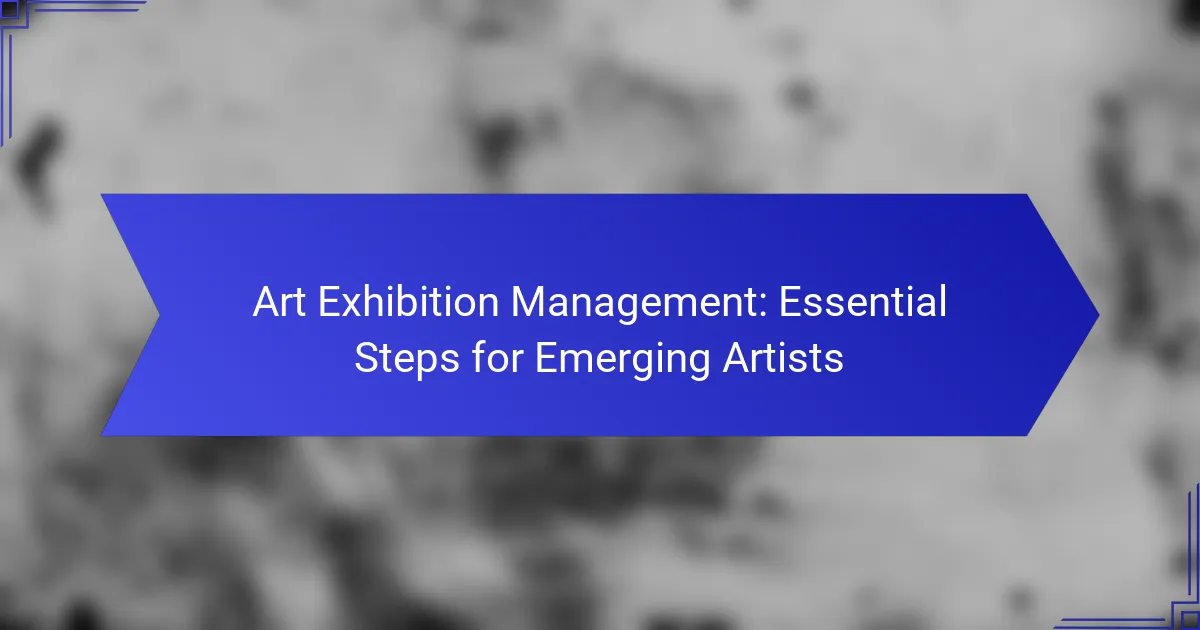Managing an art exhibition as an emerging artist involves a series of strategic steps that can significantly enhance your visibility and impact within the art community. From selecting the right venue to engaging with local organizations and promoting your work through social media, each decision plays a vital role in creating a successful showcase. By carefully planning and executing these elements, you can effectively connect with your audience and elevate your artistic presence.
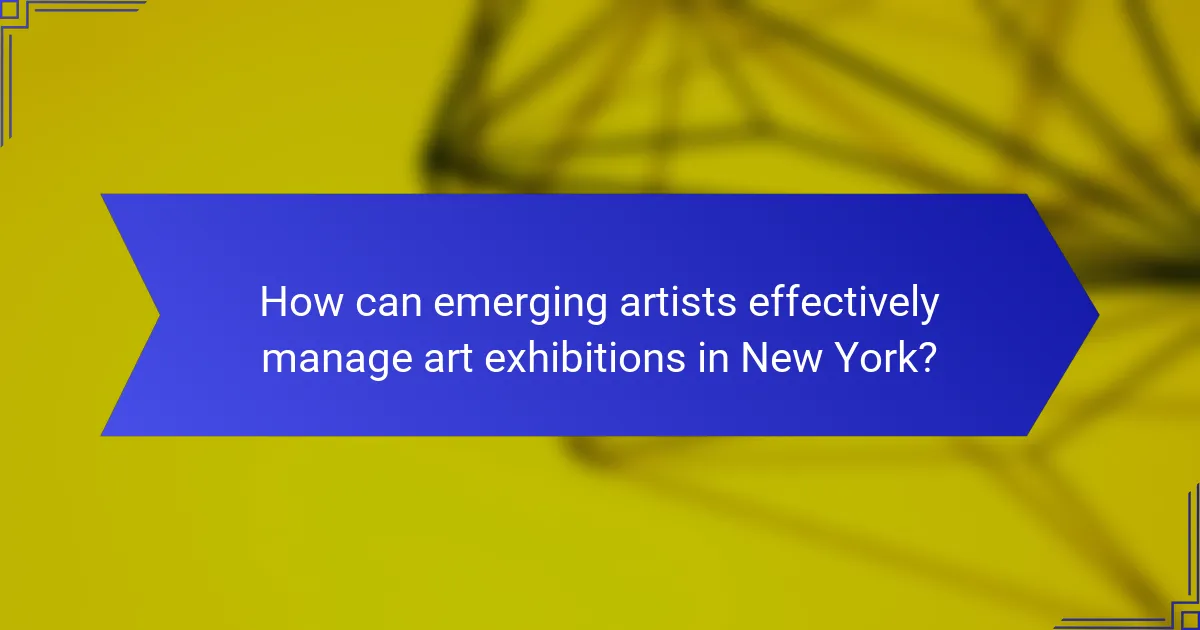
How can emerging artists effectively manage art exhibitions in New York?
Emerging artists can effectively manage art exhibitions in New York by strategically selecting venues, engaging with local organizations, and utilizing social media for promotion. These steps help create visibility and foster connections within the vibrant New York art scene.
Utilize local art galleries for venue
Choosing the right venue is crucial for a successful exhibition. Local art galleries in New York often have established audiences and can provide essential support in terms of logistics and promotion. Consider galleries that align with your artistic style and target demographic.
When approaching galleries, prepare a professional portfolio and a clear exhibition proposal. Highlight how your work complements their existing exhibitions and how it can attract visitors. Many galleries may charge a rental fee or take a commission on sales, so be sure to discuss these terms upfront.
Engage with community art organizations
Community art organizations in New York can be valuable allies for emerging artists. These organizations often host events, provide resources, and connect artists with potential collaborators and audiences. Look for local art collectives, non-profits, or educational institutions that support emerging talent.
Participating in workshops, networking events, or group exhibitions organized by these organizations can enhance your visibility and credibility. Building relationships within these communities can lead to future opportunities and collaborations that may benefit your artistic career.
Leverage social media for promotion
Social media is a powerful tool for promoting art exhibitions. Platforms like Instagram, Facebook, and Twitter allow artists to reach a broad audience quickly and effectively. Create engaging content that showcases your artwork, shares behind-the-scenes insights, and announces exhibition details.
Consider using targeted ads to reach specific demographics in New York. Collaborating with local influencers or art bloggers can also amplify your reach. Regularly engage with your audience through comments and messages to build a loyal following and encourage attendance at your exhibition.
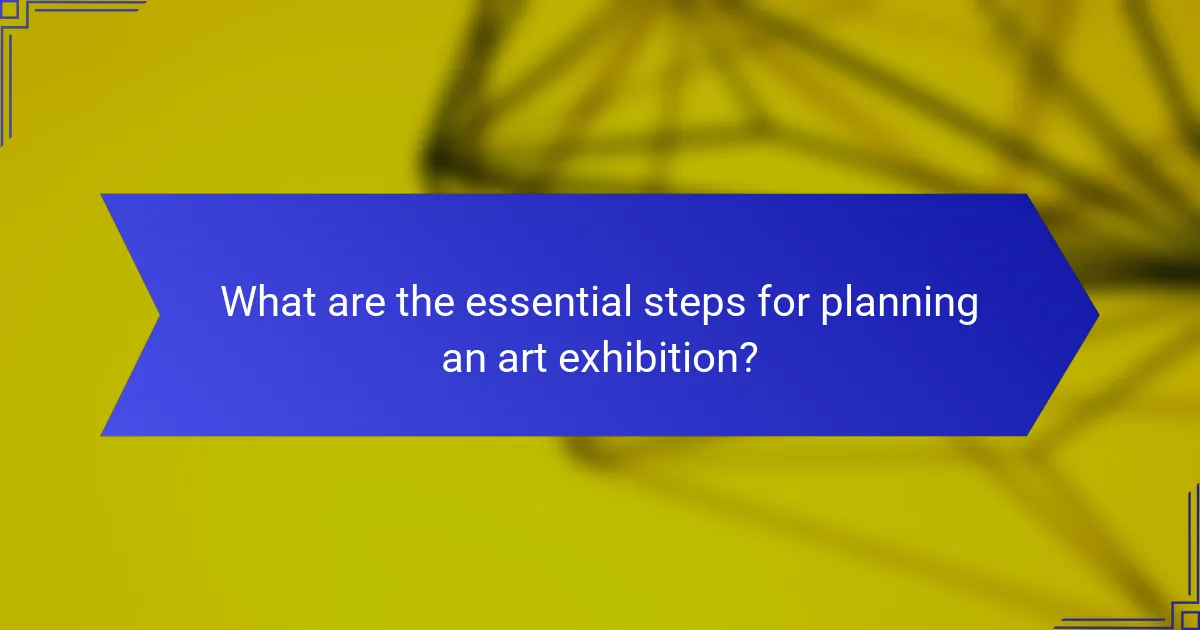
What are the essential steps for planning an art exhibition?
Planning an art exhibition involves several key steps to ensure a successful showcase of your work. From defining a theme to selecting artworks, each step plays a crucial role in the overall experience for both the artist and the audience.
Define the exhibition theme
Choosing a clear and engaging theme is fundamental for your exhibition. The theme should reflect your artistic vision and resonate with your target audience, creating a cohesive narrative throughout the display.
Consider current trends, personal experiences, or social issues as potential themes. For example, an exhibition could focus on environmental concerns, showcasing works that highlight nature and sustainability.
Set a budget and timeline
Establishing a budget and timeline is essential for effective exhibition planning. Determine costs for venue rental, marketing, materials, and any additional expenses, aiming for a budget that aligns with your financial capacity.
Set a timeline that includes key milestones, such as securing a venue, finalizing artwork selection, and launching promotional efforts. A typical timeline might span several months, allowing ample time for preparation and adjustments.
Select artworks for display
Carefully curating the artworks for your exhibition is critical to its success. Choose pieces that align with your defined theme and showcase your artistic range. Aim for a balanced mix of styles, sizes, and mediums to engage viewers.
Consider the logistics of displaying each artwork, including framing, installation, and lighting. A checklist can help ensure you account for each piece’s requirements, such as dimensions and any special handling instructions.
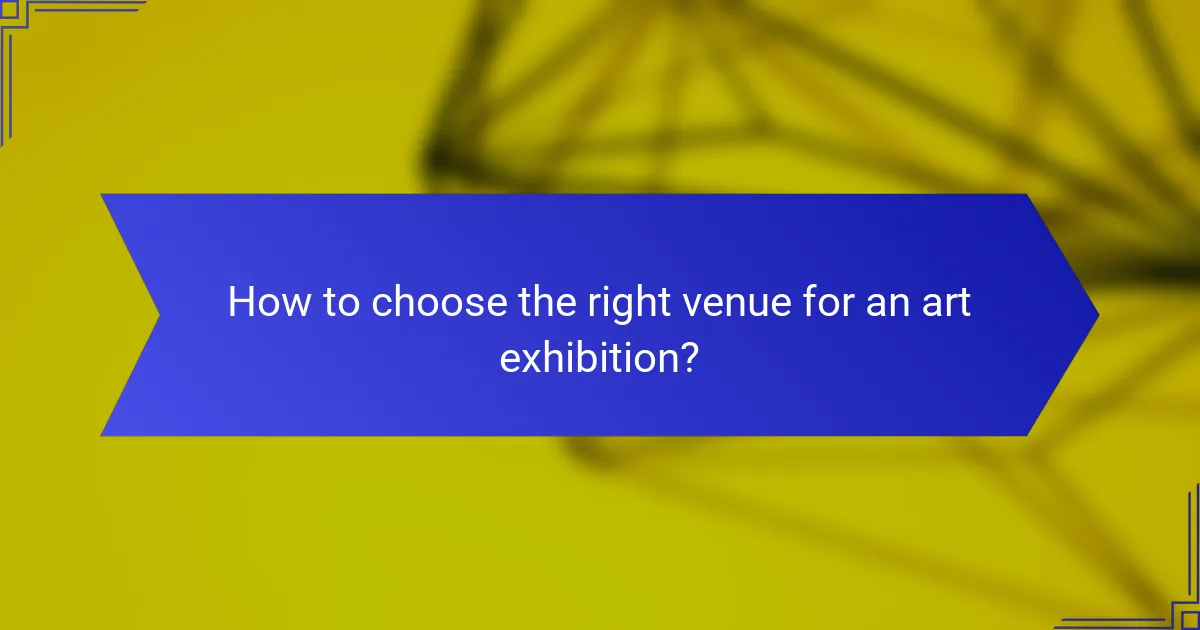
How to choose the right venue for an art exhibition?
Choosing the right venue for an art exhibition is crucial for attracting visitors and showcasing your work effectively. Consider factors such as location, accessibility, and the overall atmosphere to ensure your exhibition meets your goals.
Consider foot traffic and accessibility
Foot traffic is essential for maximizing visitor numbers at your exhibition. Look for venues located in busy areas, such as art districts or popular shopping streets, where potential attendees are likely to pass by. Ensure the venue is easily accessible by public transport and has parking options nearby.
Accessibility also includes accommodating individuals with disabilities. Check if the venue has ramps, elevators, and accessible restrooms to ensure everyone can enjoy your exhibition.
Evaluate venue size and layout
The size and layout of the venue should align with the scale of your exhibition. A small collection may feel lost in a large space, while a crowded venue can overwhelm visitors. Aim for a venue that allows for comfortable movement and viewing of the artwork.
Consider the layout as well; an open floor plan can facilitate a natural flow, while distinct areas for different pieces can create a more engaging experience. Visualize how your artworks will be displayed and ensure the venue supports your vision.
Assess rental costs and amenities
Rental costs can vary significantly based on location and venue features. Establish a budget before you start looking and compare prices across different venues. Factor in additional costs such as insurance, utilities, and cleaning fees to get a complete picture of the financial commitment.
Amenities can enhance your exhibition experience. Look for venues that offer lighting, display equipment, and sound systems. Some venues may also provide marketing support or access to a built-in audience, which can be beneficial for emerging artists.
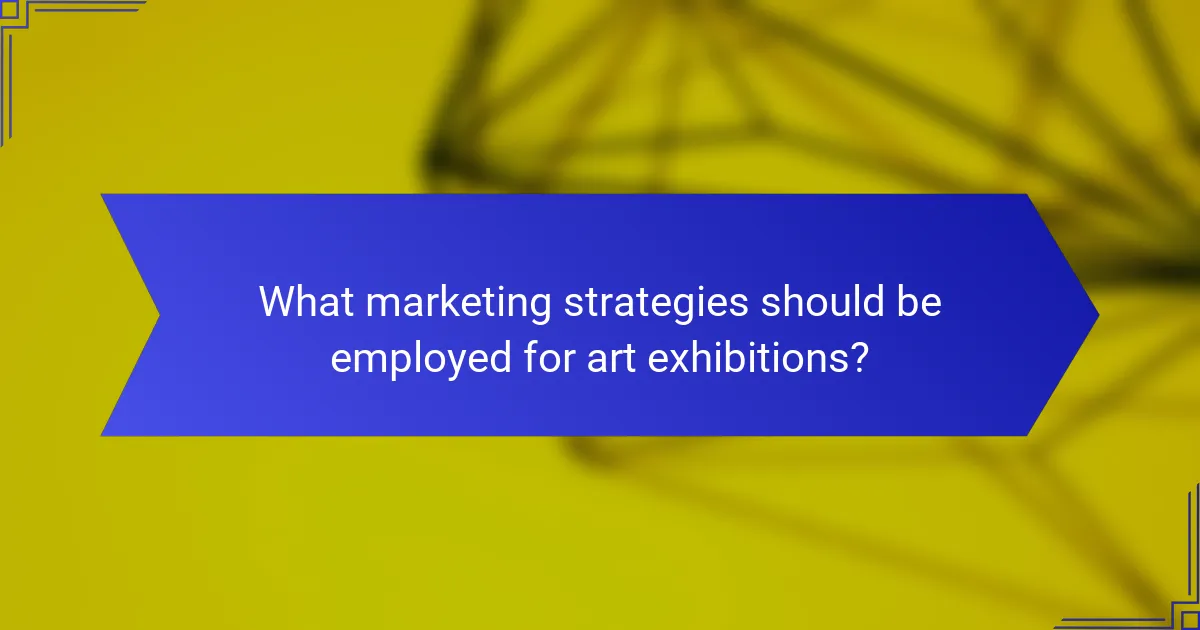
What marketing strategies should be employed for art exhibitions?
Effective marketing strategies for art exhibitions include creating an event page, utilizing email marketing, and collaborating with local influencers. These approaches help attract a wider audience and generate interest in your artwork.
Create an event page on platforms like Eventbrite
Creating an event page on platforms like Eventbrite is essential for promoting your art exhibition. This page serves as a central hub for information, including dates, times, location, and ticketing options. Ensure that the page is visually appealing and includes high-quality images of your artwork.
Consider adding features such as RSVP options and social sharing buttons to encourage attendees to invite friends. Regularly update the page with any new details or changes to keep potential visitors informed.
Utilize email marketing to reach potential attendees
Email marketing is a powerful tool for reaching potential attendees for your exhibition. Build a mailing list by collecting emails from previous contacts, social media followers, and event page visitors. Send out newsletters that highlight your artwork, provide exhibition details, and offer exclusive previews.
Keep your emails concise and visually engaging. Use compelling subject lines to increase open rates and include clear calls to action, such as links to your event page or ticket purchase options.
Collaborate with local influencers for promotion
Collaborating with local influencers can significantly enhance your exhibition’s visibility. Identify influencers in the art community or related fields who resonate with your style and values. Reach out to them with a proposal for collaboration, such as inviting them to the exhibition or providing exclusive content for their platforms.
Influencers can share your event with their followers, expanding your reach and attracting a diverse audience. Consider offering them incentives, like free tickets or exclusive previews, to encourage their participation and promote your exhibition effectively.
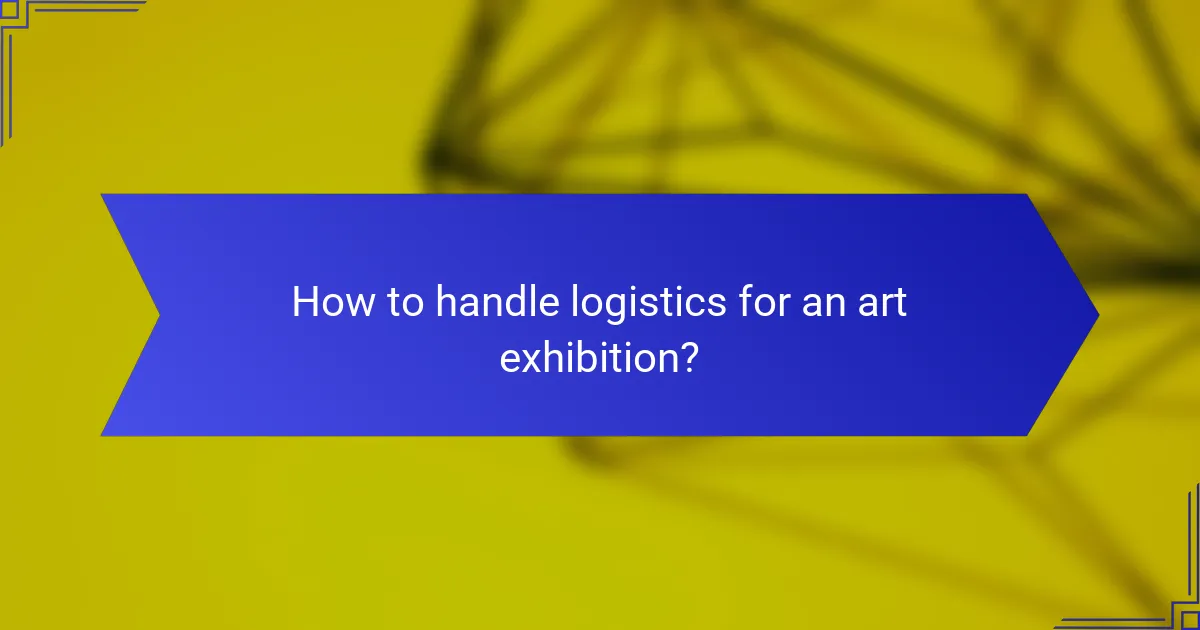
How to handle logistics for an art exhibition?
Handling logistics for an art exhibition involves careful planning and execution to ensure that artworks are transported, installed, and insured properly. Key considerations include organizing transportation, planning installation and deinstallation processes, and securing insurance coverage for the artworks.
Organize transportation for artworks
Transportation is crucial for the safe delivery of artworks to the exhibition venue. Consider using specialized art transport services that understand the fragility and value of the pieces. Ensure that vehicles are climate-controlled and equipped with proper padding to prevent damage during transit.
When planning transportation, establish a timeline that allows for potential delays. It’s advisable to schedule the transport a few days before the exhibition opens to accommodate any unforeseen issues. Always confirm the route and check for any road restrictions that may affect access to the venue.
Plan for installation and deinstallation
Installation and deinstallation require meticulous planning to ensure that artworks are displayed correctly and safely. Create a detailed layout of the exhibition space, including the placement of each piece, lighting considerations, and visitor flow. This layout should be shared with the installation team in advance.
During installation, have a checklist to ensure that all artworks are accounted for and properly secured. After the exhibition, plan for a systematic deinstallation process to avoid damage. Consider hiring professionals who specialize in art handling to assist with both installation and deinstallation.
Ensure insurance coverage for artworks
Insurance coverage is essential to protect artworks from potential damage or loss during transportation and the exhibition. Research insurance providers that specialize in art coverage, as they will understand the unique needs of your exhibition. Ensure that the policy covers all phases, including transit, installation, and display.
When obtaining insurance, provide detailed descriptions and valuations of each artwork. This documentation will help in securing adequate coverage and facilitate claims if necessary. Regularly review and update your insurance policy to reflect any changes in the exhibition or the value of the artworks.

What are the common challenges faced by emerging artists in exhibition management?
Emerging artists often encounter several challenges in managing exhibitions, including limited resources, lack of experience, and difficulties in marketing their work. These obstacles can hinder their ability to successfully showcase their art and connect with potential buyers or audiences.
Limited Financial Resources
Many emerging artists operate on tight budgets, which can restrict their options for venue selection, promotional activities, and materials needed for the exhibition. It’s crucial to prioritize spending and seek cost-effective solutions, such as collaborating with local galleries or community spaces that may offer lower rental fees.
Consider applying for grants or crowdfunding to supplement your budget. Platforms like Kickstarter or GoFundMe can help raise funds while also building an audience for your work.
Lack of Experience in Exhibition Planning
Inexperience can lead to missteps in planning and executing an exhibition. Emerging artists may struggle with logistics, such as setting up the space, organizing the timeline, and ensuring that all necessary permits are obtained. Seeking mentorship from established artists or joining local artist collectives can provide valuable insights and guidance.
Creating a detailed checklist of tasks and deadlines can help manage the planning process effectively. This should include everything from venue booking to marketing strategies.
Marketing and Promotion Challenges
Effectively marketing an exhibition is vital for attracting visitors and potential buyers. Emerging artists often lack the connections or knowledge to promote their events successfully. Utilizing social media platforms, such as Instagram and Facebook, can help reach a broader audience at little to no cost.
Building an email list and sending out newsletters can also keep your audience informed about upcoming exhibitions. Collaborating with local influencers or art bloggers can further enhance visibility.
